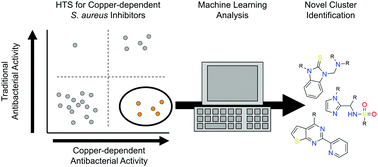High-throughput screening and Bayesian machine learning for copper-dependent inhibitors of Staphylococcus aureus†
Abstract
One potential source of new antibacterials is through probing existing chemical libraries for copper-dependent inhibitors (CDIs), i.e., molecules with antibiotic activity only in the presence of copper. Recently, our group demonstrated that previously unknown staphylococcal CDIs were frequently present in a small pilot screen. Here, we report the outcome of a larger industrial anti-staphylococcal screen consisting of 40 771 compounds assayed in parallel, both in standard and in copper-supplemented media. Ultimately, 483 had confirmed copper-dependent IC50 values under 50 μM. Sphere-exclusion clustering revealed that these hits were largely dominated by sulfur-containing motifs, including benzimidazole-2-thiones, thiadiazines, thiazoline formamides, triazino-benzimidazoles, and pyridinyl thieno-pyrimidines. Structure–activity relationship analysis of the pyridinyl thieno-pyrimidines generated multiple improved CDIs, with activity likely dependent on ligand/ion coordination. Molecular fingerprint-based Bayesian classification models were built using Discovery Studio and Assay Central, a new platform for sharing and distributing cheminformatic models in a portable format, based on open-source tools. Finally, we used the latter model to evaluate a library of FDA-approved drugs for copper-dependent activity in silico. Two anti-helminths, albendazole and thiabendazole, scored highly and are known to coordinate copper ions, further validating the model's applicability.



 Please wait while we load your content...
Please wait while we load your content...